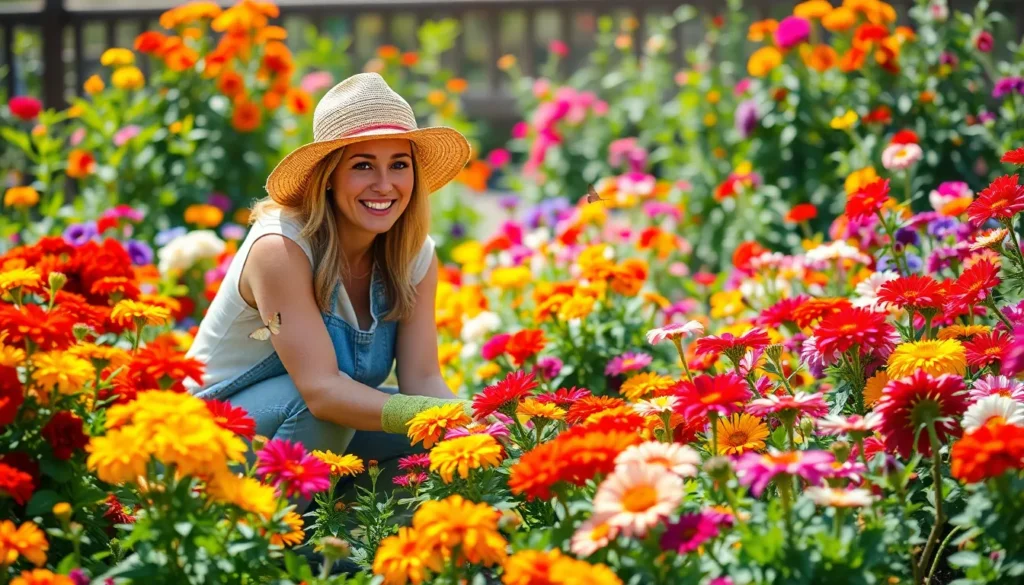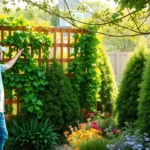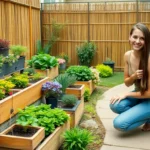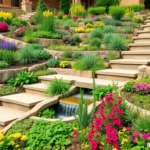Creating a stunning garden that bursts with color and fragrance starts with choosing the right flowers. We’ve all dreamed of having that perfect outdoor space where vibrant blooms create a natural masterpiece that’ll make neighbors stop and stare. Whether you’re a seasoned gardener or just starting your green-thumb journey, selecting the ideal flowers can transform any yard into a breathtaking sanctuary.
The secret lies in understanding which flowers thrive in your exact climate while complementing your garden’s style and maintenance needs. From cheerful annuals that provide instant gratification to perennials that return year after year, we’ll guide you through proven flower combinations that guarantee spectacular results.
Ready to discover the flower varieties that’ll elevate your garden from ordinary to extraordinary? Let’s explore time-tested options that bloom beautifully and create the garden oasis you’ve always wanted.
Annual Flowers That Bloom All Season Long
Annual flowers provide the perfect foundation for gardens that need reliable color from spring until the first frost. We’ve selected three powerhouse varieties that deliver exceptional performance with minimal maintenance requirements.
Marigolds for Vibrant Color and Pest Control
Marigolds offer dual benefits as both stunning ornamental plants and natural pest deterrents for our garden spaces. These hardy annuals produce bold orange, yellow, and red blooms that continue flowering from late spring through fall. We recommend planting French marigolds (Tagetes patula) for compact borders or African marigolds (Tagetes erecta) for dramatic height in back garden areas.
Natural compounds in marigold roots and leaves repel harmful insects like aphids, whiteflies, and nematodes. This makes them excellent companion plants for vegetables like tomatoes, peppers, and beans. We’ve found that marigolds thrive in full sun conditions and tolerate drought once established, making them perfect for low maintenance garden designs.
Petunias for Continuous Blooms and Easy Care
Petunias deliver an abundance of trumpet shaped flowers in colors ranging from deep purple to bright pink and pristine white. Wave petunias and grandiflora varieties spread quickly to create stunning ground cover or cascading displays in hanging baskets. We plant these annuals in well draining soil with at least six hours of direct sunlight daily.
Regular deadheading encourages continuous blooming throughout the growing season, though many newer varieties are self cleaning. Water petunias at soil level rather than overhead to prevent fungal diseases and maintain healthy foliage. These versatile flowers adapt well to containers, garden beds, and window boxes in both formal and cottage garden styles.
Zinnias for Bold Colors and Butterfly Attraction
Zinnias produce some of the most vibrant and diverse flower colors available in annual garden plants. State Fair Mix varieties can reach heights of three feet with dinner plate sized blooms, while dwarf varieties like ‘Profusion’ stay compact at 12 inches tall. We plant zinnias directly in the garden after soil temperatures reach 70°F for optimal germination rates.
These heat loving flowers attract butterflies, bees, and hummingbirds to our garden spaces throughout summer and fall. Cut flower varieties like ‘Benary’s Giant’ provide excellent stems for indoor arrangements while continuing to produce new blooms outdoors. Zinnias prefer full sun locations with good air circulation to prevent powdery mildew in humid climates.
Perennial Flowers That Return Year After Year
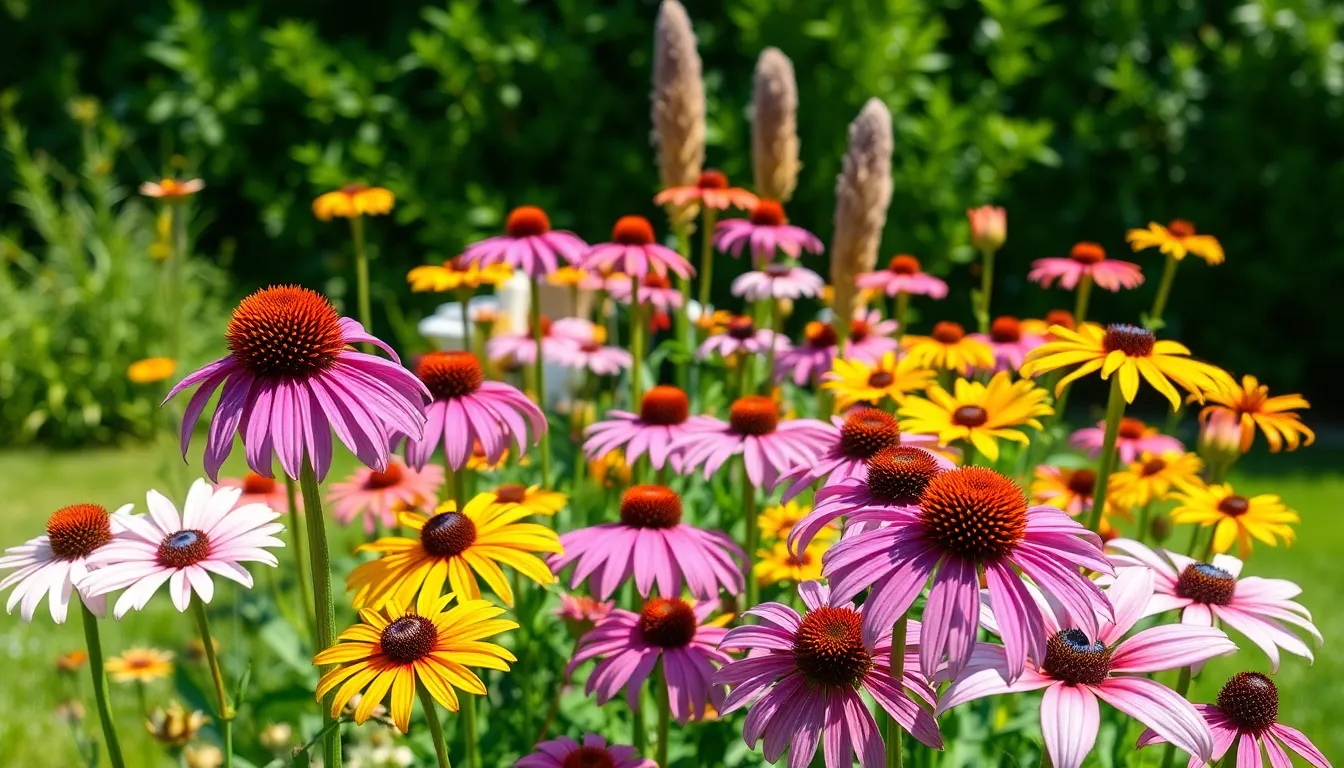
Perennial flowers offer gardeners the gift of returning blooms season after season with minimal replanting effort. These hardy plants establish deep root systems and adapt well to various climates, making them perfect investments for long-term garden success.
Coneflowers for Low Maintenance Beauty
Coneflowers (Echinacea genus) stand out as one of our most reliable perennial choices for effortless garden beauty. These resilient plants thrive in diverse soil types and tolerate drought conditions once established, requiring virtually no special attention from busy gardeners.
Echinacea purpurea, commonly known as purple coneflower, produces vibrant blooms that attract essential pollinators like bees, butterflies, and birds throughout the growing season. Their deep taproots naturally improve soil health while helping control garden pests without chemical interventions.
Blooming periods extend from early summer through fall, providing months of continuous color and wildlife activity. We recommend planting coneflowers in full sun locations where they’ll develop their most robust growth and abundant flowering displays.
Black-Eyed Susans for Drought Tolerance
Black-Eyed Susans (Rudbeckia spp.) excel in challenging garden conditions where other flowers might struggle to survive. These golden beauties produce cheerful, daisy-like blooms from mid-summer through fall, brightening landscapes with their sunny disposition.
Drought tolerance makes these perennials ideal for water-wise gardening approaches or areas with inconsistent rainfall patterns. Once established, they require minimal supplemental watering and adapt readily to poor soil conditions that would challenge more finicky flowering plants.
Pest and disease resistance adds another layer of low-maintenance appeal, allowing gardeners to enjoy consistent blooms without frequent interventions. Their robust nature and extended flowering period make them valuable additions to naturalized areas, wildflower gardens, or traditional perennial borders.
Daylilies for Versatile Garden Placement
Daylilies (Hemerocallis spp.) adapt to more garden situations than almost any other perennial flower we can recommend. These versatile plants thrive in both partial shade and full sun conditions, making them suitable for challenging spots where other flowers won’t perform well.
Continuous summer blooming provides reliable color from early season through late summer, with individual flowers lasting just one day but new buds opening constantly. Available colors range from soft pastels to bold oranges and deep burgundies, offering options for every garden color scheme.
Clumping growth habits make daylilies excellent choices for mass plantings, border edges, or mixed perennial beds where you need dependable performance. Their minimal care requirements and ability to multiply naturally over time provide exceptional value for gardeners seeking maximum impact with minimal effort.
Spring Bulb Flowers for Early Season Color
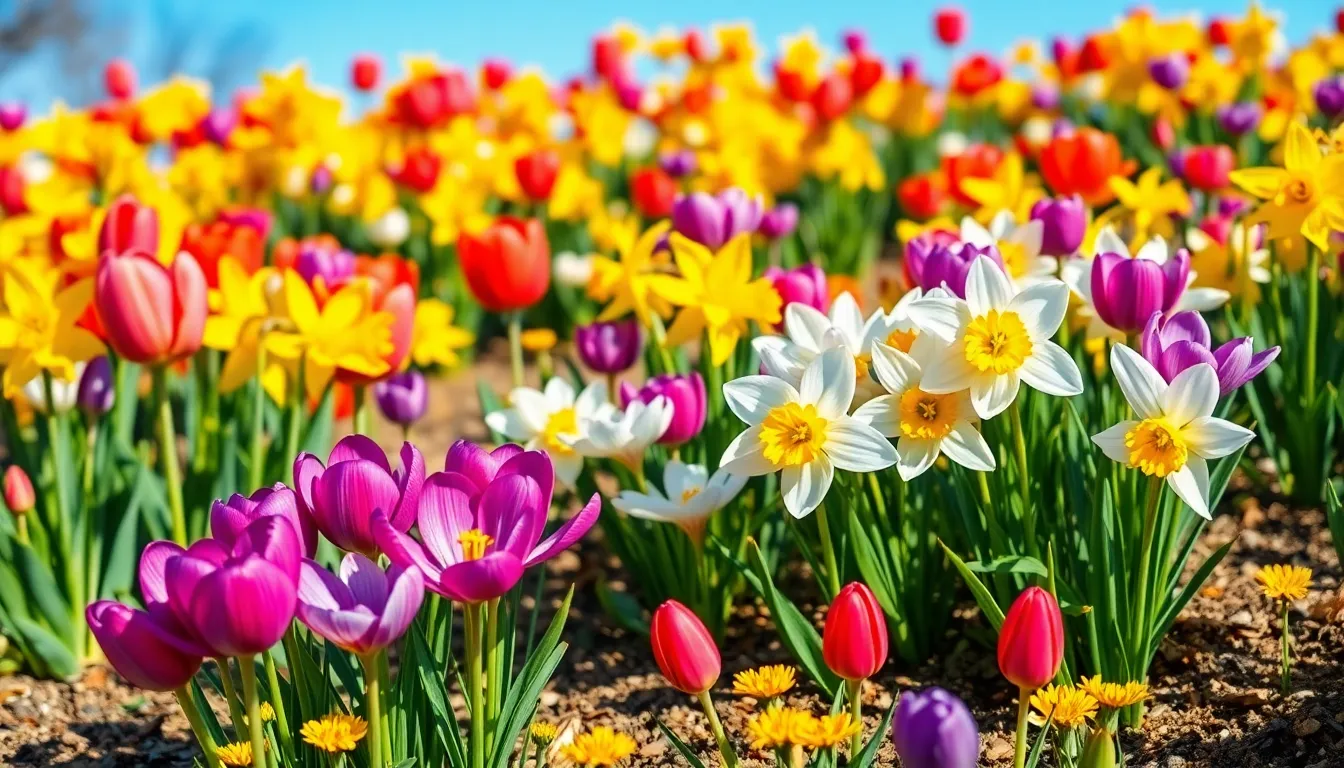
We can transform our gardens into vibrant displays even before summer arrives by strategically planting spring bulb flowers. These early bloomers create stunning color combinations and establish the foundation for seasonal garden beauty.
Tulips for Classic Garden Elegance
Tulips bring sophisticated charm to our gardens with their distinctive cup-shaped blooms and vibrant color palette. We’ll find these classic flowers perfect for formal garden designs where structured beauty takes center stage. Their wide range of varieties allows us to create coordinated color schemes or bold contrasts that complement our garden’s overall aesthetic. These elegant blooms emerge as dependable performers in spring landscapes, offering us the opportunity to establish refined garden spaces that impress visitors and neighbors alike.
Daffodils for Naturalized Plantings
Daffodils excel in creating effortless, natural-looking garden areas that require minimal ongoing maintenance. We can plant these bright yellow beauties in areas where we want that authentic, undisturbed woodland appearance. Their ability to be left undisturbed means we’ll enjoy expanding colonies of cheerful blooms year after year without replanting efforts. These hardy flowers thrive in naturalized settings like meadow gardens, woodland edges, or informal industry areas where their spreading habit creates increasingly impressive displays over time.
Crocuses for Ground-Covering Displays
Crocuses provide us with the perfect solution for early spring ground coverage that bursts with vibrant colors. We can plant these low-growing bulbs under our lawns or throughout garden beds to create stunning carpet-like displays. Their compact size makes them ideal for filling spaces between larger plantings or creating colorful borders along pathways. These reliable bloomers emerge through snow and cold weather, giving us confidence that our gardens will showcase beautiful colors even during unpredictable early spring conditions.
Summer Blooming Flowers for Peak Season Impact
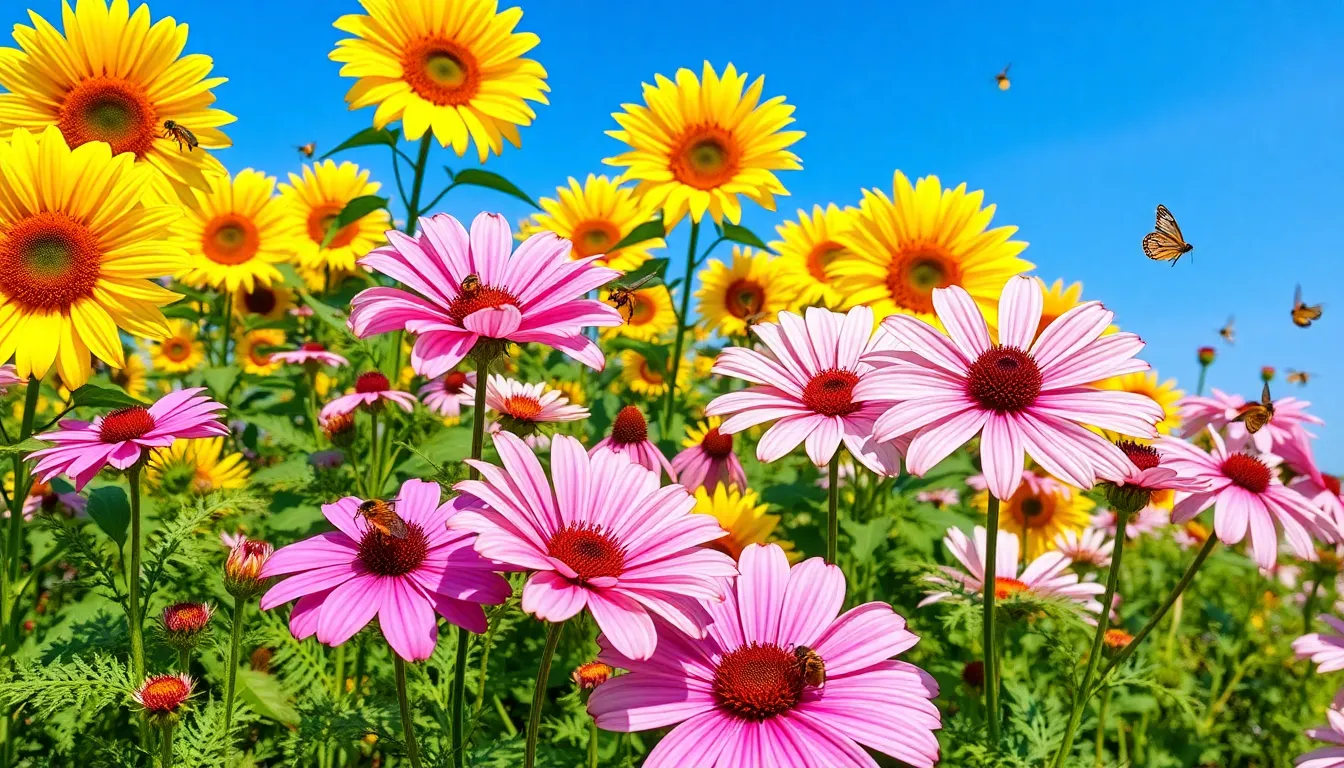
Summer brings opportunities to showcase bold, statement-making flowers that transform your garden into a captivating display. These powerhouse bloomers create maximum visual impact during the growing season’s peak months.
Sunflowers for Dramatic Height and Wildlife Appeal
Sunflowers create towering vertical elements that reach 6 to 12 feet or more in your garden space. These dramatic annuals (Helianthus annuus) produce bold yellow or multi-colored blooms that serve as focal points in any industry design. Their large, nectar-rich flower heads attract essential pollinators like bees and butterflies throughout the growing season.
Wildlife benefits extend beyond pollinator support since sunflower seed-rich centers provide valuable food sources for birds during late summer and fall. We recommend planting sunflowers in full sun locations with well-drained soil for optimal growth. Regular watering helps establish strong root systems, though mature plants require minimal maintenance while supporting ever-changing garden ecosystems.
Cosmos for Delicate Texture and Self-Seeding
Cosmos (Cosmos bipinnatus) offer airy, fern-like foliage that creates beautiful textural contrast against bolder garden elements. Their daisy-like flowers bloom in delicate shades of pink, white, and magenta from early summer through fall. Self-seeding capabilities make cosmos particularly valuable since they return year after year with minimal gardener intervention.
These adaptable annuals thrive in full sun conditions and actually prefer poor soil, making them perfect for challenging garden spots. Butterflies and bees find cosmos flowers irresistible, ensuring your garden buzzes with pollinator activity. We appreciate how cosmos provide continuous color throughout the longest growing months while requiring virtually no maintenance once established.
Cleome for Unique Spider-Like Blooms
Cleome (Cleome hassleriana) brings unusual architectural interest with its distinctive spider-like flower clusters. These tall annuals reach 4 to 5 feet in height, creating striking vertical accents topped with spidery blossoms in pink, white, and purple. Spider flowers add quirky personality that distinguishes gardens from typical plantings.
Drought tolerance makes cleome ideal for water-wise gardening approaches while still delivering impressive visual impact. Hummingbirds visit cleome flowers regularly, adding another layer of wildlife attraction to your summer garden. Seed pods naturally self-sow, ensuring future generations appear with little effort from gardeners who want reliable, low-maintenance beauty.
Fall Flowering Plants for Extended Garden Interest
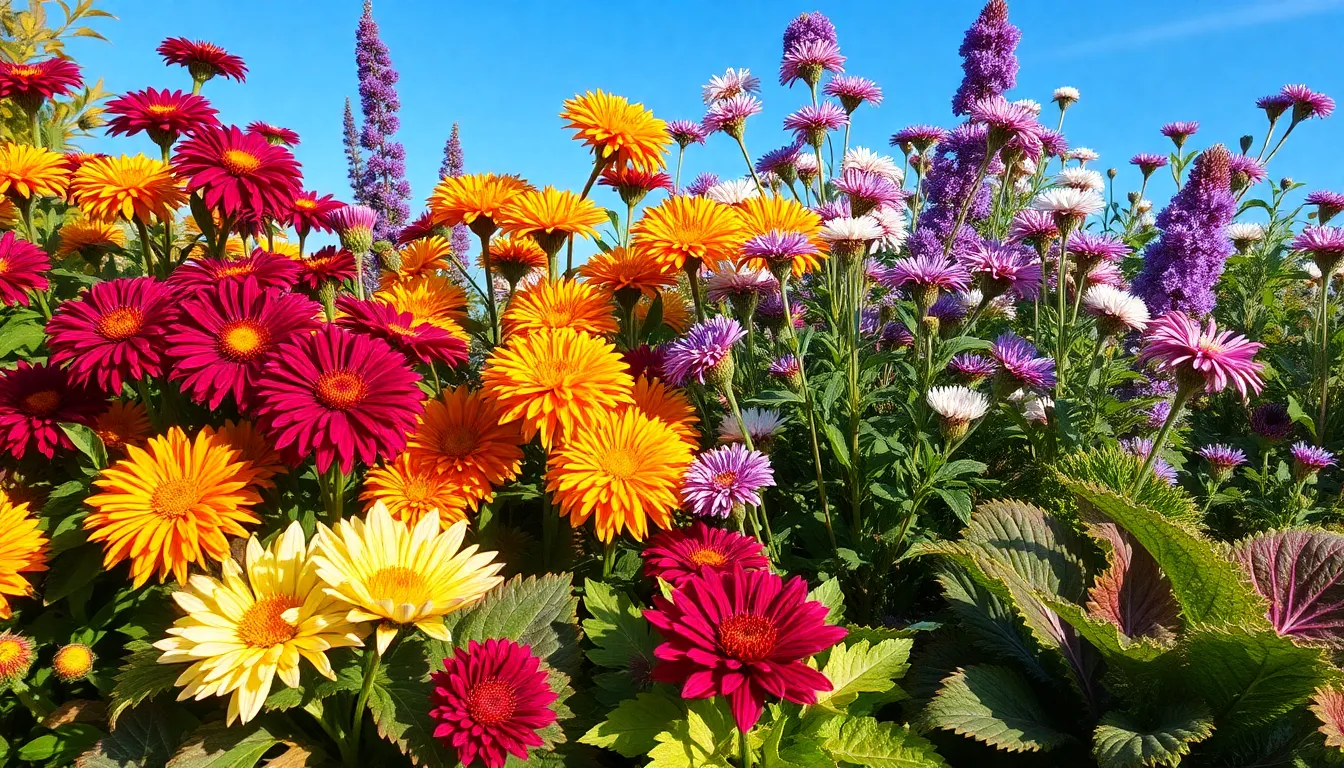
As summer fades, we can maintain vibrant garden displays well into autumn with strategic plant selections. These hardy performers thrive in cooler temperatures and provide essential color when most other flowers begin to decline.
Chrysanthemums for Autumn Color Variety
Chrysanthemums deliver reliable autumn color from September until the first frost strikes our gardens. We’ll find these classic fall bloomers growing 1 to 3 feet tall in full sun conditions across zones 5-9. Their blooms showcase vibrant colors including deep burgundy, golden yellow, rust orange, and rich purple shades that perfectly complement autumn’s natural palette.
Best practices for mums include:
- Planting in well-draining soil with full sun exposure
- Choosing varieties like cushion mums for compact growth
- Selecting decorative mums such as spoon-tip or quill types for unique textures
- Pinching growing tips in early summer to encourage bushier plants
- Watering at soil level to prevent fungal issues
Mums excel in both garden beds and containers, making them versatile additions to our fall displays. Their longevity and color variety establish them as essential plants for extending garden interest through autumn months.
Asters for Late Season Pollinator Support
Asters provide crucial nectar sources for pollinators during late summer and autumn when food becomes scarce. We can count on their daisy-like flowers in purple, pink, and white shades to attract butterflies, bees, and beneficial insects extending their active season. These hardy perennials typically reach 2 to 4 feet in height and thrive in full sun conditions.
Key aster varieties for fall gardens:
| Variety | Height | Bloom Color | Special Features |
|---|---|---|---|
| New England Aster | 3-6 feet | Purple, pink | Attracts monarch butterflies |
| Aromatic Aster | 2-4 feet | White, pale blue | Drought tolerant |
| Smooth Aster | 3-5 feet | Blue, purple | Spreads naturally |
Asters fill garden gaps with cheerful, long-lasting blooms that create movement and texture in autumn borders. Their ecological value makes them particularly important for supporting wildlife as natural food sources dwindle.
Ornamental Kale for Foliage and Form
Ornamental kale transforms fall gardens with striking foliage in green, white, pink, and purple combinations. We appreciate how these cool-weather plants maintain their colorful leaves long after flowering plants fade, providing structure and visual interest through autumn and early winter. Their rosette formation grows 8 to 12 inches tall and wide, creating perfect focal points in containers and garden beds.
Design applications for ornamental kale:
- Creating textural contrast with late-blooming flowers
- Filling containers alongside mums and asters
- Establishing colorful borders along pathways
- Adding vertical elements to low-growing autumn displays
- Providing winter interest in mild climate zones
Ornamental kale tolerates frost better than most plants, often developing more intense colors as temperatures drop. We can combine these foliage plants with celosia’s feathery burgundy and orange flowers or Russian sage’s frothy blue blooms to create layered, visually compelling autumn arrangements that extend garden beauty well into the cooler months.
Shade-Loving Flowers for Difficult Garden Areas
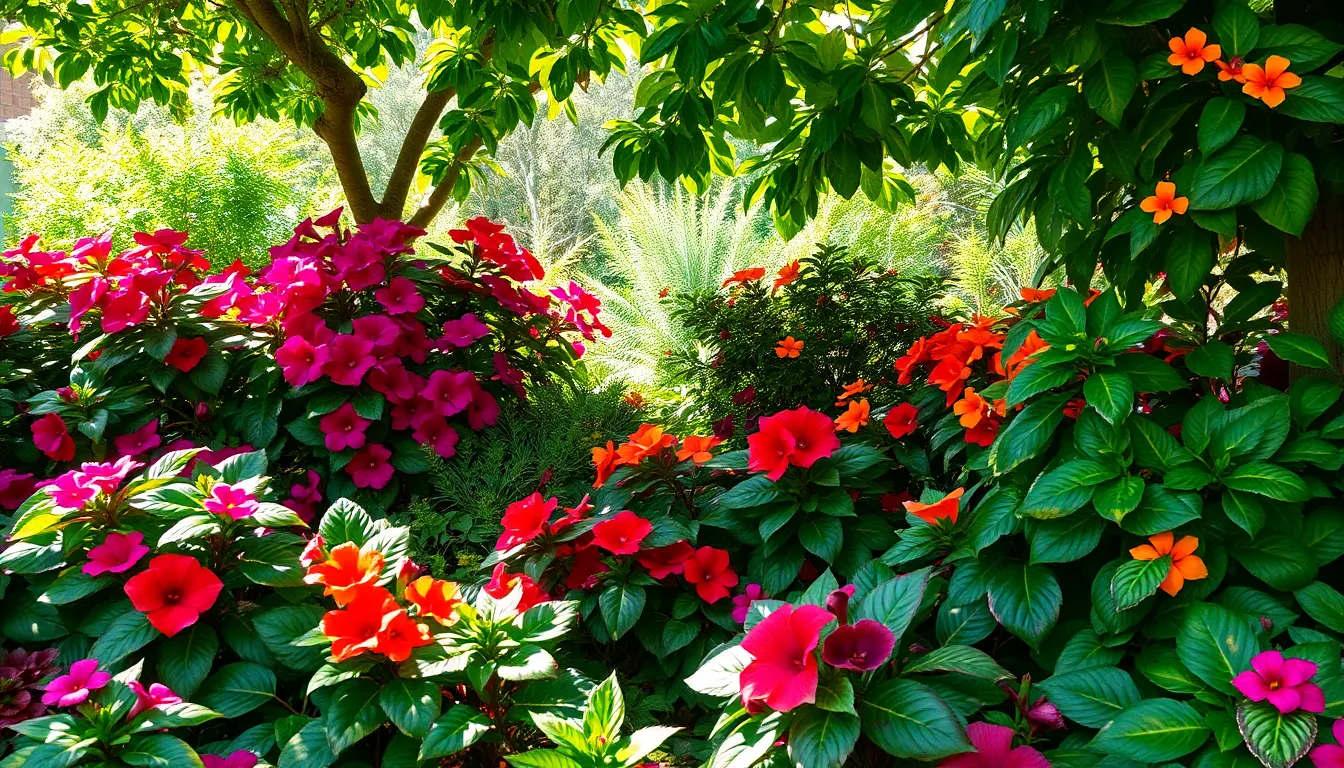
When our gardens feature challenging spots with limited sunlight, we can still create stunning displays with the right plant choices. Shade loving flowers transform these difficult areas into vibrant showcases that complement our sunnier garden spaces.
Impatiens for Continuous Shade Blooms
Impatiens deliver reliable color from spring through fall in our shadiest garden corners. These versatile flowers thrive where other plants struggle, providing months of continuous blooms without demanding full sun exposure.
SunPatiens represent an exceptional hybrid variety that performs beautifully in partial to full shade conditions. Even though their name suggesting sun preference, these plants excel in shaded environments while also tolerating some direct sunlight. We’ll find them particularly valuable for their adaptability and non-stop flowering habit throughout the growing season.
Traditional Impatiens walleriana varieties offer another excellent choice for consistent shade performance. These plants require minimal maintenance once established and create dense, colorful displays that brighten even the darkest garden spaces.
Begonias for Colorful Foliage and Flowers
Begonias provide dual beauty through both striking flowers and ornamental foliage in our shaded garden areas. These adaptable plants offer multiple planting options, from containers and hanging baskets to direct ground installation.
Flower colors span a wide spectrum, giving us flexibility to match existing garden color schemes or create bold contrasts. Foliage patterns and shapes add visual interest beyond the blooming period, ensuring our shade gardens maintain appeal throughout the season.
Low maintenance requirements make begonias ideal for busy gardeners seeking maximum impact with minimal effort. We can rely on these plants to perform consistently in challenging conditions where many other flowers fail to thrive.
Caladiums for Dramatic Leaf Patterns
Caladiums create bold focal points through their heart shaped, vividly patterned leaves rather than traditional flowers. These tropical plants excel in warm, shaded environments where their dramatic foliage becomes the main attraction.
Leaf patterns range from subtle veining to striking color combinations that rival any flower display. We can use caladiums as underplanting beneath taller shade plants or as standalone specimens in prominent garden locations.
Well draining soil and protection from harsh midday sun ensure optimal caladium performance. These plants require consistent moisture and warm temperatures but reward us with some of the most dramatic foliage displays available for shaded garden areas.
Sun-Loving Flowers for Bright Garden Spots
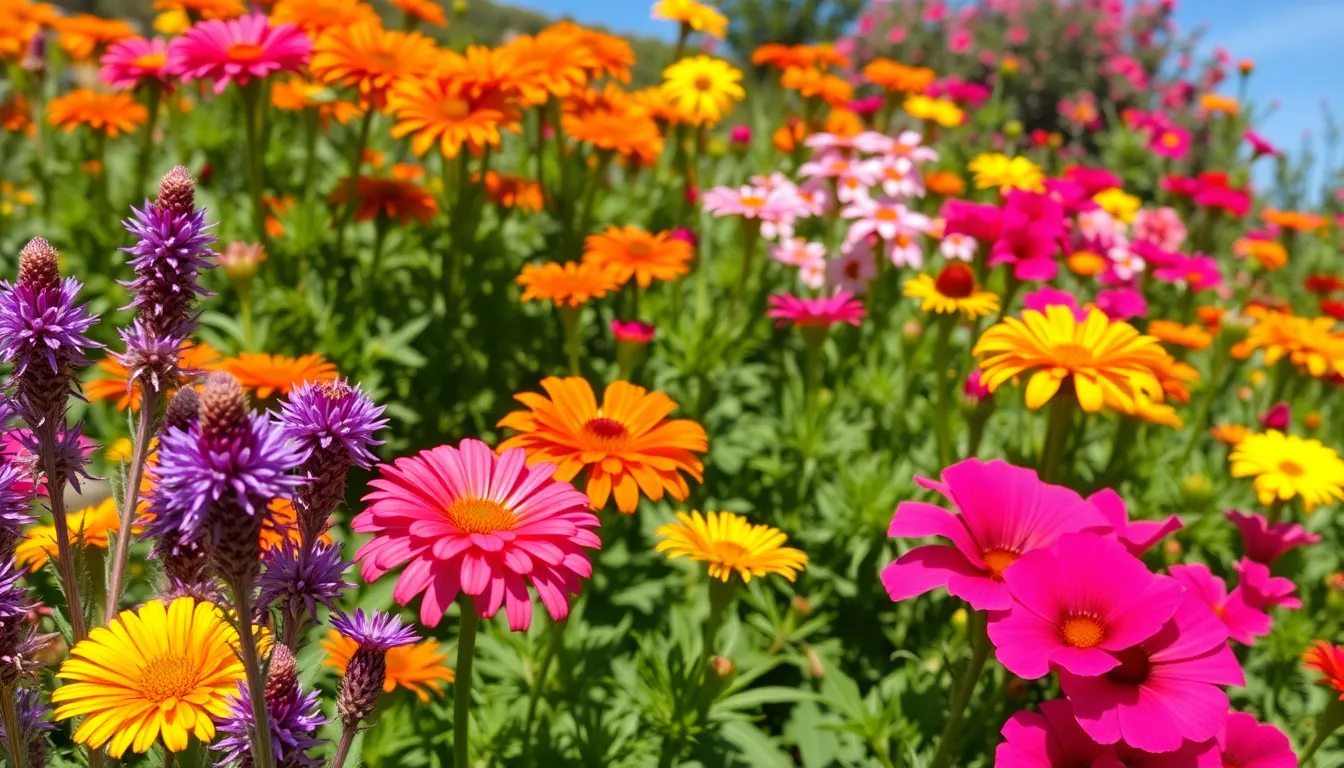
Bright, sunny areas in our gardens offer perfect opportunities to showcase vibrant blooms that thrive in intense sunlight. We’ll explore three exceptional sun-loving flowers that deliver stunning visual impact while handling the hottest conditions with ease.
Salvia for Spiky Texture and Heat Tolerance
Salvia creates dramatic vertical interest with its distinctive spiky flower clusters that rise boldly above garden beds. These heat-tolerant perennials withstand scorching temperatures that would wilt other flowers, making them ideal for challenging sunny spots. We recommend planting salvias in well-drained soil where they’ll receive full sun exposure throughout the day.
Varieties like Salvia nemorosa produce purple, blue, or white flower spikes that bloom from late spring through fall. Their drought-resistant nature means we can reduce watering once established, while their sturdy stems require no staking even though reaching heights of 18-24 inches. Salvias also attract hummingbirds and butterflies, adding movement and life to sunny garden spaces.
Lantana for Butterfly Gardens and Hot Climates
Lantana transforms sunny areas into butterfly magnets with its clusters of small, colorful flowers that bloom continuously in hot weather. These low-maintenance shrubs produce flowers in vibrant combinations of orange, yellow, red, pink, and white that create eye-catching displays from spring until frost. We’ve found lantanas particularly valuable in regions with intense summer heat where other flowers struggle to perform.
Spreading varieties like Lantana camara work beautifully as ground covers in rock gardens or cascading from containers. Their drought tolerance makes them perfect for xeriscaping projects, while their ability to attract monarchs, swallowtails, and other butterflies enhances garden biodiversity. Plant lantanas in full sun with well-drained soil for optimal flowering and pest resistance.
Portulaca for Rock Gardens and Dry Conditions
Portulaca excels in the harshest sunny conditions where most flowers fail, producing vibrant blooms even though minimal water and poor soil. These succulent annuals create carpets of colorful flowers in shades of pink, orange, yellow, red, and white that open in bright sunlight. We love using portulacas in rock gardens, between stepping stones, and in containers where drainage is excellent.
Moss rose varieties spread low and wide, filling spaces with their needle-like foliage and cup-shaped flowers that close at night. Their water-storing ability means we can plant them in sandy or gravelly soils without irrigation systems. Seeds scatter naturally, creating new plants the following season, making portulacas both economical and self-sustaining for challenging sunny locations.
Fragrant Flowers for Sensory Garden Appeal
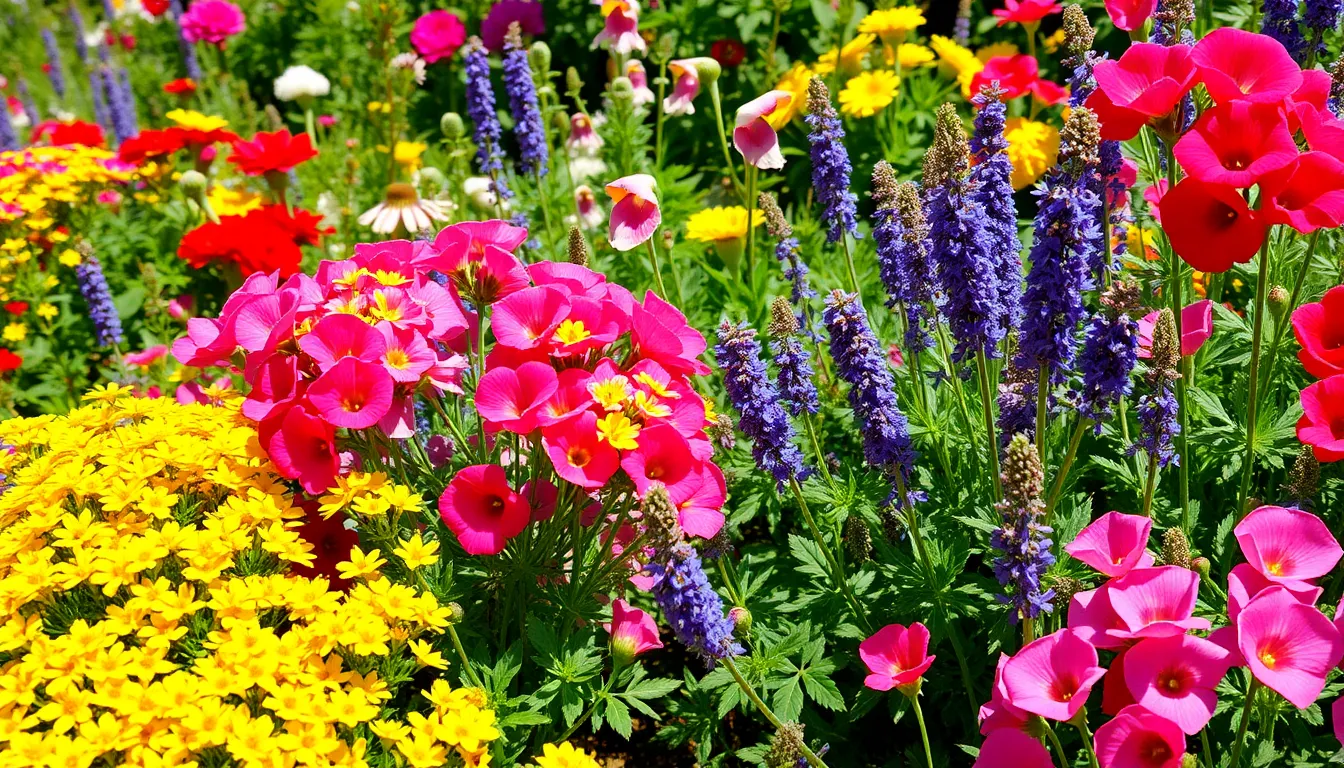
Moving beyond visual beauty, we can transform our gardens into multi-sensory experiences through carefully selected fragrant flowers. These aromatic blooms enhance both accessibility and enjoyment for all garden visitors.
Sweet Alyssum for Ground Cover Fragrance
Sweet Alyssum (Lobularia maritima) creates a fragrant carpet of tiny blooms that releases honey-like scents throughout your garden. This low-growing annual produces clusters of small white, lavender, or pink flowers that attract beneficial insects while providing continuous ground coverage. We love how Sweet Alyssum blooms from spring to fall, offering months of delightful fragrance that intensifies during cooler evening hours. Plant it along pathways, in rock gardens, or as edging where foot traffic can release its sweet aroma naturally.
Lavender for Aromatic Herb Garden Integration
Lavender (Lavandula) stands as our top choice for combining visual appeal with therapeutic fragrance in sunny garden locations. These perennial herbs produce striking purple flower spikes that release calming scents known to reduce stress and attract pollinators like bees and butterflies. We recommend planting lavender in well-drained soil where it thrives with minimal water requirements once established. Harvest the flowers for dried arrangements, sachets, or culinary uses to extend the sensory experience beyond your garden borders.
Sweet Peas for Climbing Scented Blooms
Sweet Peas (Lathyrus odoratus) deliver intense fragrance through their climbing vines that produce vibrant flowers in shades of pink, purple, white, and red. These annual climbers excel on trellises, fences, or obelisks where their strong, sweet scent can fill entire garden areas. We’ve found Sweet Peas thrive in cool weather conditions and benefit from regular harvesting to encourage continuous blooming throughout the growing season. Their enduring fragrance makes them exceptional choices for cut flower arrangements that bring garden scents indoors.
Native Wildflowers for Eco-Friendly Gardens
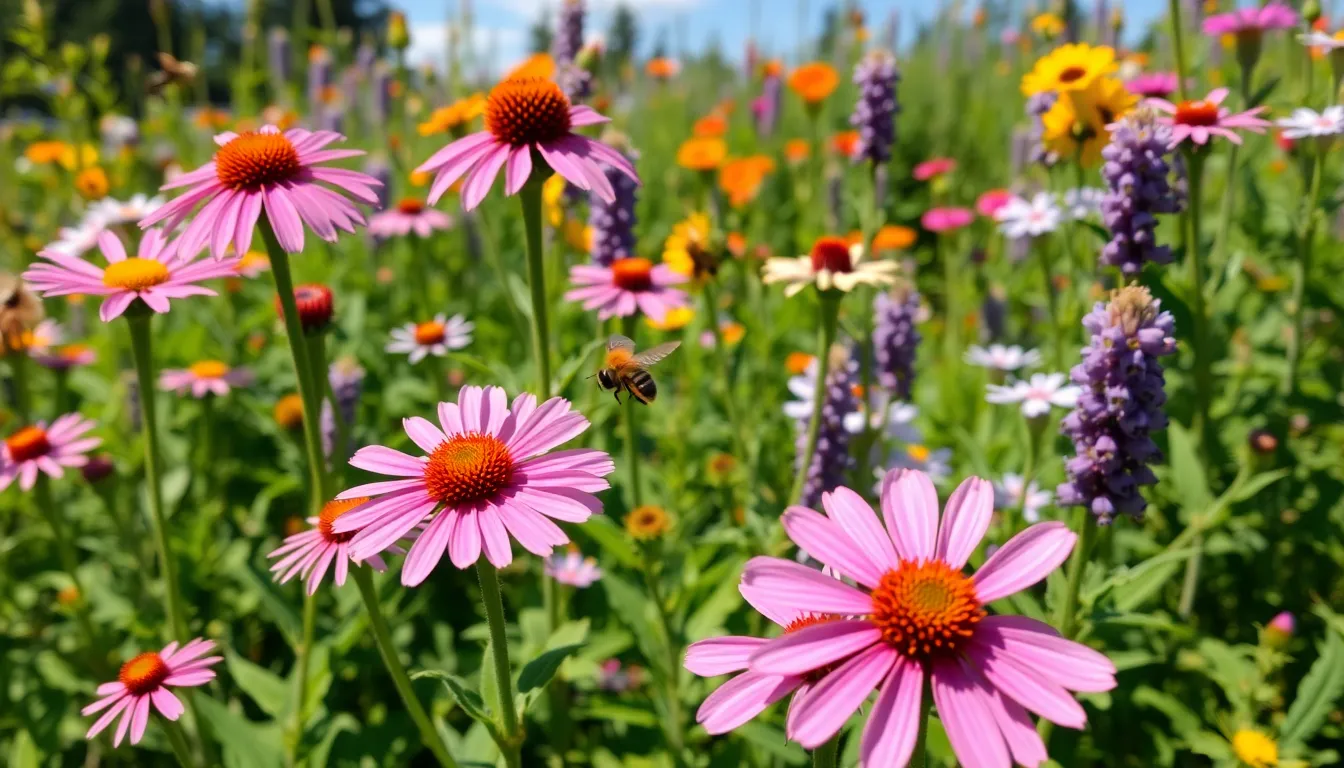
Native wildflowers offer us the perfect opportunity to create sustainable gardens that support local ecosystems while reducing our environmental impact. These regionally adapted plants require less water, fertilizer, and maintenance compared to non-native species, making them ideal choices for eco-conscious gardeners seeking beautiful, low-maintenance landscapes.
Purple Coneflower for Regional Adaptation
Purple Coneflower delivers exceptional drought tolerance and adaptability across various soil types, making it our top choice for sustainable garden designs. We love how its striking purple-pink petals surround prominent seed cones, creating visual interest throughout the growing season while attracting bees, butterflies, and birds to our gardens.
Regional adaptation makes Purple Coneflower incredibly resilient in local climate conditions, thriving without supplemental watering once established. Growing 2-3 feet tall, this native wildflower blooms from midsummer through fall, providing consistent color when many other plants begin to fade.
Seeds from Purple Coneflower heads offer valuable food sources for goldfinches and other songbirds during autumn and winter months. We recommend leaving spent flower heads intact rather than deadheading to maximize wildlife benefits and allow natural reseeding for expanded displays in future seasons.
Bee Balm for Pollinator-Friendly Landscaping
Bee Balm produces vibrant red, pink, or purple blooms that serve as magnets for essential pollinators including bees, hummingbirds, and butterflies. We appreciate how its strong fragrance and tubular flowers make it particularly attractive to these beneficial creatures while adding aromatic appeal to our garden spaces.
Fertile, well-drained soil provides optimal growing conditions for Bee Balm, though it adapts to various soil types with proper drainage. Growing 2-4 feet tall, this native wildflower spreads gradually through underground rhizomes, creating natural colonies that support larger pollinator populations over time.
Versatility allows us to incorporate Bee Balm into both naturalistic meadow gardens and formal industry designs with equal success. We find it pairs beautifully with other native plants like Purple Coneflower and Wild Bergamot, creating cohesive pollinator-friendly plantings that bloom in succession throughout the summer.
Wild Bergamot for Natural Garden Settings
Wild Bergamot offers soft lavender flowers and aromatic mint-family foliage that blends seamlessly into naturalistic garden landscapes. We value its preference for sunny sites and well-drained soil, making it perfect for prairie-style gardens and wildflower meadows that celebrate local plant communities.
Long blooming periods extend from mid-summer through early fall, providing consistent nectar sources when many spring flowers have finished. Growing 2-3 feet tall with a spreading habit, Wild Bergamot creates textural diversity while supporting beneficial insects throughout the extended flowering season.
Natural garden settings benefit from Wild Bergamot’s ability to self-seed and establish sustainable populations without intensive management. We find its drought tolerance particularly valuable in water-wise landscapes, where it continues blooming even during dry spells that stress less adapted plants.
Container-Friendly Flowers for Small Spaces
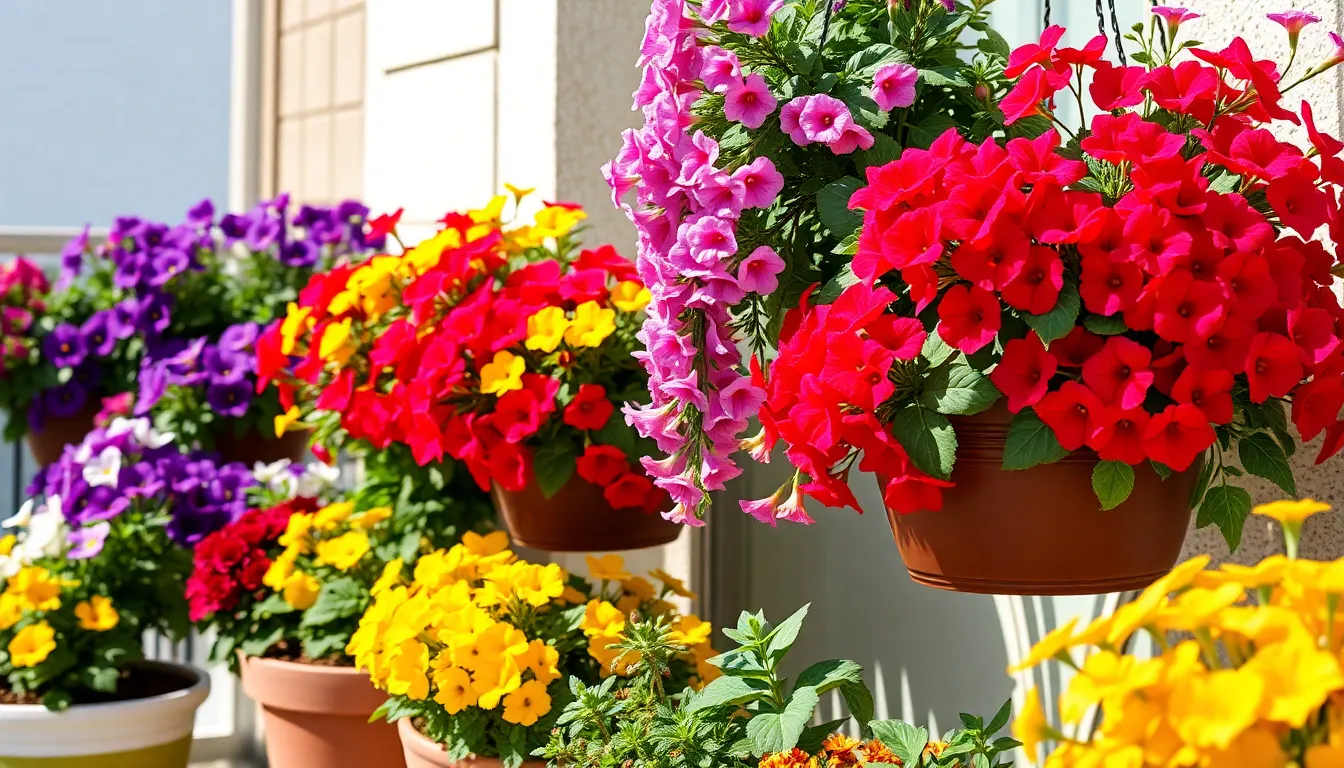
When working with limited gardening space, we can transform patios, balconies, and small yards into vibrant displays using the right container flowers. These compact options thrive in pots while delivering maximum visual impact.
Pansies for Cool Weather Container Displays
Pansies excel in cooler months when many other flowers struggle to bloom. We love these delicate beauties for their vibrant colors that brighten containers during fall, winter, and early spring seasons. Their compact size makes them perfect for small pots and window boxes.
These hardy flowers tolerate frost better than most annuals, continuing to produce cheerful blooms even when temperatures drop. Pansies come in stunning color combinations including purple, yellow, orange, and white, allowing us to create coordinated container arrangements. We can plant them in autumn for continuous color through winter in most climates.
Calibrachoa for Trailing Basket Arrangements
Calibrachoa, commonly known as Million Bells, creates spectacular cascading displays in hanging baskets and tall containers. These prolific bloomers produce hundreds of small petunia-like flowers that spill gracefully over container edges. We find them incredibly versatile for creating dramatic vertical interest in small spaces.
Their trailing habit makes them ideal companion plants for upright flowers in mixed container gardens. Calibrachoa thrives in sunny locations while requiring minimal maintenance once established. We appreciate how these flowers bloom continuously from spring until frost without needing deadheading.
Geraniums for Classic Pot Garden Appeal
Geraniums remain our top choice for classic container gardens due to their reliability and long-lasting blooms. These traditional favorites offer vibrant colors including red, pink, white, and coral that complement any outdoor space. We find them exceptionally easy to care for, making them perfect for beginner container gardeners.
Their sturdy stems and compact growth habit make geraniums ideal for both small pots and large container arrangements. These flowers thrive in sunny locations while tolerating some drought conditions better than many container plants. We can overwinter geraniums indoors in colder climates, making them a cost-effective choice for ongoing container displays.
Conclusion
Creating a stunning flower garden doesn’t have to be overwhelming when you know which blooms work best for your exact conditions. We’ve covered everything from season-long annuals to reliable perennials that’ll return year after year without replanting.
Whether you’re working with sunny spots or shady corners containers or wide-open beds there’s a perfect flower combination waiting to transform your outdoor space. The key is matching the right plants to your garden’s unique conditions and your maintenance preferences.
Remember that the most beautiful gardens often combine different types of flowers—mixing annuals for instant color perennials for long-term structure and native varieties for ecological benefits. Start with a few of our recommended varieties and watch as your garden becomes the vibrant sanctuary you’ve always envisioned.
Frequently Asked Questions
What are the best annual flowers that bloom all season long?
The top three annual flowers for continuous blooms are marigolds, petunias, and zinnias. Marigolds offer vibrant colors and natural pest control, petunias provide adaptable continuous blooms, and zinnias attract butterflies with their bold colors. All three thrive in full sun, require minimal maintenance, and bloom from spring until the first frost.
Which perennial flowers are best for low-maintenance gardens?
Coneflowers, black-eyed Susans, and daylilies are excellent low-maintenance perennials. These flowers return year after year, reducing replanting efforts. They’re drought-tolerant, attract pollinators, and thrive in various conditions. Coneflowers improve soil health, black-eyed Susans adapt to challenging conditions, and daylilies provide continuous summer color in different light conditions.
What spring bulb flowers provide the earliest garden color?
Tulips, daffodils, and crocuses are ideal spring bulb flowers for early season color. Tulips offer classic elegance with coordinated color schemes, daffodils naturalize and expand yearly with minimal maintenance, and crocuses create vibrant ground cover that emerges even through snow. These bulbs establish a foundation for seasonal garden beauty.
Which summer flowers create the most dramatic visual impact?
Sunflowers, cosmos, and cleome are perfect for bold summer displays. Sunflowers provide dramatic height and attract pollinators and birds, cosmos offer delicate texture with self-seeding capabilities, and cleome features unique spider-like blooms with drought tolerance. These flowers thrive in full sun and support local wildlife during peak growing season.
How can I maintain garden color into autumn?
Chrysanthemums, asters, and ornamental kale extend garden beauty into fall. Mums provide reliable autumn color in various vibrant hues, asters serve as crucial nectar sources for late-season pollinators, and ornamental kale offers striking foliage that maintains color long after other plants fade. These selections ensure captivating displays through cooler months.
What flowers work best in shaded garden areas?
Impatiens, begonias, and caladiums excel in shaded conditions. Impatiens bloom continuously in low-light areas, begonias offer striking flowers with ornamental foliage, and caladiums provide dramatic leaf patterns as bold focal points. These shade-loving plants transform difficult spots into vibrant displays with minimal maintenance requirements.
Which flowers thrive in full sun and hot conditions?
Salvia, lantana, and portulaca are exceptional sun-loving flowers. Salvia features spiky flower clusters with excellent heat tolerance, lantana attracts butterflies with vibrant blooms and low maintenance needs, and portulaca produces colorful flowers with minimal water requirements. These varieties ensure stunning displays in bright, sunny locations throughout summer.
What are the best fragrant flowers for sensory gardens?
Sweet Alyssum, lavender, and sweet peas offer exceptional fragrance. Sweet Alyssum provides honey-like scent with ground cover capabilities, lavender offers calming fragrance with culinary uses, and sweet peas deliver intense fragrance with climbing ability. These aromatic blooms create multi-sensory garden experiences while providing visual beauty.
Why should I consider native wildflowers in my garden?
Native wildflowers like Purple Coneflower, Bee Balm, and Wild Bergamot require less water, fertilizer, and maintenance than non-native species. They’re naturally adapted to local conditions, attract essential pollinators, and support local ecosystems. These sustainable choices contribute to eco-friendly landscaping while providing beautiful, low-maintenance garden displays.
What flowers work best for container gardens in small spaces?
Pansies, calibrachoa, and geraniums excel in container gardening. Pansies offer cool-weather resilience with vibrant colors for fall through spring, calibrachoa provides cascading blooms perfect for hanging baskets, and geraniums deliver reliability with long-lasting appeal. These container-friendly options maximize visual impact in limited gardening spaces.

